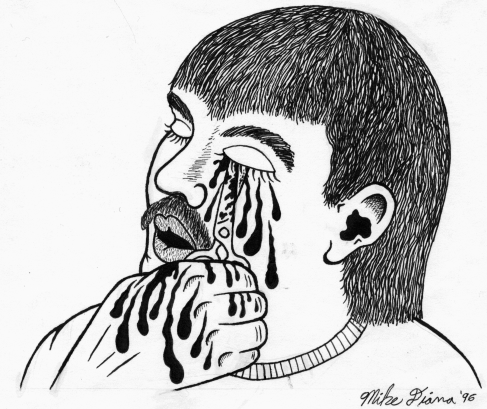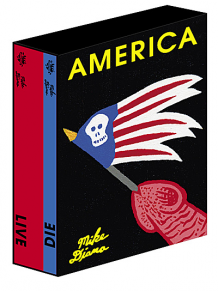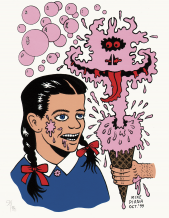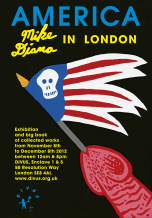Before the TV cameras and the furious news people parked outside his house looking for a statement, before the activists endorsing respect to the First Amendment that protects freedom of expression in the United States compared his trial to the crucifixion of Christ, and long before the court in Pinellas County found him guilty of three minor charges for the distribution, publishing and advertising of obscene comic books, Michael C. Diana was a normal teenager who began to draw cartoons in the 80’s emulating the work of his role models. These were among others: Basil Wolverton, Greg Irons, Robert Crumb, Clay Wilson and the artists of Zap Comix, the paradigmatic underground magazine that during the 60’s formed the new panorama of comic books in the United States of America.
For the young Diana, the works of Clay Wilson were liberating. In one of his comics dating from the 60s, Wilson presents us with the story of Captain Pissgums and his Perverted Pirates. In it, the perverted pirates, a band of “lice infested losers, sadists, masochists and sodomites” get lost on their voyage across the seven seas and while away the time smoking opium and taking turns to cum into their Captain’s mouth.
But however close to his œuvre, these explorations of sex through exaggeration and the questioning of the day to day ready formulas for living that the Zap Comix artists initiated, they were still deeply different to the art of the young Diana who in 1994 was imprisoned for four days in a maximum security prison in the state of Florida, U.S. for publishing the now infamous comic book Boiled Angel.
In Boiled Angel Diana opened a door to an interior world brutally afflicted by reality, by the death of naivety, by the disappearance of every ideal and by the most raw and distorted violence. Influenced by, but far — graphically, thematically and ideologically — from the artists of Zap Comix, Diana is closer to the tradition of terrifying alienation constant in the literary works of Kafka. In Diana’s world as in Kafka’s, the characters are victims of unreasonable and often baffling forces beyond their, and our, comprehension. Happy endings are impossible in the tormented journeys of Diana’s personages, who are victims, in the first place, of his appalling and inflexible universes.
The ultimate futilities of the characters struggles are constantly being pointed out by a sadistic author who rejoices in the absurdity of the real world. Frequent references to the present the World Trade Centre towers as they collapse, newspaper trimmings reporting teenage suicides and cases of pederasty, to name but a few, remind us that the author is not always the mastermind behind these twisted fantasies, usually there is a perpetrator before him.
Religion, family, childhood, friendship, school, adolescence, community and justice; these are all platforms for Diana’s ultra violence. In his stories every human expression of sexuality is depraved. Even extraterrestrials and balloons shaped like animals are depraved. There is no possible sincerity or honesty within his world. Instead, everything is part of a fabrication that mixes justice and barbarism in equal parts but neither justice nor barbarism win out. It is this ambiguity that causes such troubling results. As in Kafka, innocence is relative for Diana and the space of doubt accommodates all kinds of evil punishment. A good example is his comic Party Props (1996), where the protagonist Greg is decapitated and used as a dinner party centrepiece by his temporarily insane tupperware obsessed mother.
This sardonic comedy is probably one of Diana’s most difficult characteristics to pin down, mainly because it is impossible to describe Greg’s dismembered torso pinched back together with cocktail sticks as being exactly “funny.” Maybe the artist’s strategy relies on Freud’s relief theory of humour explicated in ‘The Joke and Its Relation to the Unconscious’ (1905), this theory states that laughter is the release of pent-up nervous energy that mounts during the telling of a joke, or in Diana’s case, the reading of a comic.
Contrary to the obvious, Diana’s virtue is not in becoming a flying banner in the fight for freedom of expression in the specific environment of comic art, but in being a relevant artist by his own merit. His themes, techniques and DIY methods that take on the ethos of punk culture stand out by themselves. However, there is no denying that his becoming a victim of so perverse scourges as the ones he draws in his cartoons has changed his life, his work and the subjects he has chosen to depict.
The violence in Boiled Angel that seemed almost repulsive, deliberately sensational and scandalous, with the passing of the years and the maturity attained by a trial in which he was found guilty, turned into a humourless comedy of daily life. There is no subtlety or ambiguity in his message: the world is abhorrent, innocence is pre-destined to die in the bloodiest way, every one of us is in part guilty – ergo punishable.
America, the title of this survey covering more than two decades of work by Mike Diana is an indication. It refers to, and exists as, a reflection of the society that deemed his artwork a crime; America LIVE/DIE are caustic satire in the face of those who, since 1969, decided to ignore the preliminary conclusions of the Presidential Commission on Obscenity and Pornography: The Commission believes that there is no warrant for continued Government interference with the full freedom of adults because extensive empirical investigation, both by the Commission and others, provides no evidence that exposure to or use of explicit sexual materials plays a significant role in the causation of social or individual harms such as crime, delinquency, sexual or non sexual deviancy or severe emotional disturbances.
This book is an affront to the political correctness that has justified Diana’s persecution since the early 90’s. But let’s not lose sight of something: Although from his pen have emanated all kinds of – frequently hilarious – horrors, we will not count among them the regret of it’s expression.






























 We Are Rising National Gallery For You! Go to Kyjov by Krásná Lípa no.37.
We Are Rising National Gallery For You! Go to Kyjov by Krásná Lípa no.37.
Kommentar
Der Artikel ist bisher nicht kommentiert wordenNeuen Kommentar einfügen